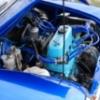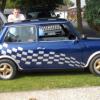Some interesting information on wheel/tyre options for Mini's from Keith Calver's Minispares blog below:-
"There are a number of things that need serious consideration no matter which wheel/tyre combination you decide to go for. First and foremost is suspension and steering component condition.
The original 10-inch combination is relatively 'forgiving' - masking slight component wear simply because it has relatively low leverage effects and dynamics as a whole. This encompasses everything affected by wheel/tyre weight and profile and the grip afforded by the tyre contact patch on the road. Wheel/tyre weight affects damper performance - their ability to keep the tyre in contact with the road surface the main issue. It also affects acceleration and deceleration generated by the 'flywheel effect' and steering by the 'gyroscope' effect. Tyre profile affects ride, comfort, handling and grip. All these conspire to exaggerate any shortcomings in the suspension and steering components. Slightly worn swivel pins, top arm bearings, bottom arm and tie-rod bushes, track-rod ends, steering rack, and wheel bearings will become very worn in a very short space of time. Tired dampers will not be able to keep the wheel/tyre in contact with the road. This can be dangerous - it will adversely affect safety, as you are completely reliant on those four small tyre contact patches whatever you do in a car. If the tyre isn't in contact with the road surface, you can't steer, stop, or go. As outlined earlier - a situation made very much more difficult in a Mini (or any front-wheel drive car) as it's all going on at the same end at the same time. Lower profile tyres have less flexible tyre walls - affecting ride quality (making it bumpier), and less compliant (will follow all ripples, bumps and cracks in the road surface). Although it has to be said that a number of modern sports cars have huge wheel/tyre set-ups to not only increase grip - the larger over-all circumference 'bridges' some bumps/holes, thus 'smoothing' the ride out by reducing/eliminating some of the smaller bumps.
Wider tyres will usually increase grip that will apply greater leverage against all the suspension locating bushes and bearings. Any that are worn will cause the increased leverage to push and pull the suspension into unwanted positions/angles. The result is a wayward car that doesn't handle well - seemingly developing a mind of it's own at inopportune moments if not all the time. The more grip the tyre develops, the easier it is for it to overcome the baking capability of the set-up on your car - the extra leverage applied by the bigger over-all diameter worsening the situation. Up-rated dampers are a must. The standard items are barely capable of dealing with the standard set-up when brand new (a nod in the direction of 'comfort' by the OE manufacturers) let alone when worn. Bigger wheels/tyres means more (un-sprung) weight to control when encountering road surface imperfections (bumps/pot-holes). The barest minimum should be 20% up-rated standard-type dampers. Personally I would only recommend starting at Kayaba 'Gas-A-Just' dampers (my current preferred type for cost/performance and fit), if not going to one of the adjustable sports types. The message here then is to make sure your whole suspension is in first class condition before contemplating the change. This is an ideal opportunity to fit up-rated components if worn bushes need replacing. Up-rated bushes offer greater resilience in both wear and movement, which will help provide greater suspension location and control when a bigger wheel/tyre combination is fitted. Essential to maintain the good 'handling' aspects believed to be endowed by the Mini's original design. And make sure your braking system is capable of dealing with your wheel/tyre choice."
"13-inch combinations. The 13-inch wheel/tyre combination brings out the worst in everything Mini suspension and brakes orientated - but to many the aesthetics far out-weigh all other considerations. And there are many considerations. Those who believe they are fitting this combination for increased grip and handling capability on a road car need to think again. Most of the 13-inch tyres are manufactured for heavier cars. This means a harder tyre compound is used. A Mini simply doesn't get the tyre up to its proper operating temperature, so the increase in grip originally hoped for doesn't materialize or isn't maximised. Wayward handling (unless suitable suspension set-up has been applied), heavy wayward steering, and exaggerated bump-steer are further consequences. These are caused by the offsets employed, necessary to get suspension clearance. 13-inchers are generally wider than standard rims, so the wheels are made with the greater portion of the extra width applied to the outside of the wheel, effectively pushing the wheel further out away from the car. This causes a greater leverage to be applied to the already poor bump-steer geometry of the Mini. The wider tyre needs different geometry settings to ensure the full footprint is road-surface bound as the lower, stiffer side-wall does not distort as easily as the 10-inch tyre types. Excessive camber - positive or negative - will cause the tyre to loose contact with the road surface when cornering or with extreme steering in-puts. This then causes the tyre to follow any deviations in road surface. The offset dimensions employed can also mean wheel spacer shims are required in certain combinations to gain clearance, and even the steering rack may need replacing with the one used on the Sportpack cars - and these are definitely not cheap, costing in excess of £100. These have built in lock-stops to reduce the turning circle to prevent the tyre scrubbing the inside of the rear of the inner front arch. Again, the types and styles are legion, so doing a comprehensive and accurate whose needs what is impossible in a few pages. The increased footprint increases drag - responsible for reduced top speed, reduced acceleration, increased fuel consumption (all neatly illustrated by the difference in performance figures between the Sportpack cars and the 12-inch shod variants, the 13-inchers suffering 6mph slower top speed and 0.6 seconds slower 0-60 with less mpg). This larger footprint-induced grip/drag increase will help with braking, but only if the brakes are equal to the task. The wheel diameter also gives a greater ('longer') leverage working against the brakes. The combined larger footprint and greater leverage means fitting 13-inchers to a drum-braked Mini is an absolute no-no. They simply over-come the applied friction capability of the shoes.Disc brakes are a must. Even the 7.5-inch S type discs are a little marginal in my opinion/experience unless steps are taken to maximise their performance envelope. The 13-inch combination is a good deal heavier in most instances than the standard set-up so up-rated dampers are an absolute must."
The full article:-
https://www.minispar...gory/Tyres.aspx
"




















